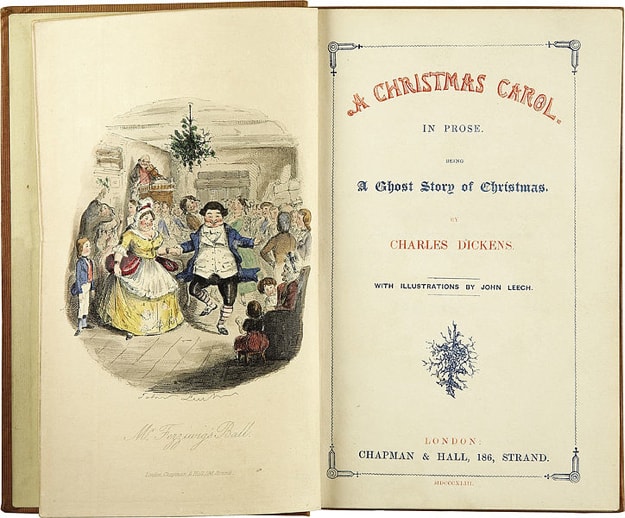
On this day in 1843 Charles Dickens’ A Christmas Carol went on sale.
Dickens was not the first author to celebrate the Christmas season in literature, but it was he who superimposed his secular vision of the holiday upon the public. The forces that impelled Dickens to create a powerful, impressive and enduring tale were the profoundly humiliating experiences of his childhood, the plight of the poor and their children during the boom decades of the 1830s and 1840s, Washington Irving’s essays on Christmas published in his Sketch Book (1820) describing the traditional old English Christmas, fairy tales and nursery stories, as well as satirical essays and religious tracts.
While Dickens’ humiliating childhood experiences are not directly described in A Christmas Carol, his conflicting feelings for his father as a result of those experiences are principally responsible for the dual personality of the tale’s protagonist, Ebenezer Scrooge. In 1824, Dickens’ father was imprisoned in the Marshalsea and twelve-year-old Charles was forced to take lodgings nearby, pawn his collection of books, leave school and accept employment in a blacking factory. The boy had a deep sense of class and intellectual superiority and was entirely uncomfortable in the presence of factory workers who referred to him as “the young gentleman”. He developed nervous fits. When his father was released at the end of a three-month stint, young Dickens was forced to continue working in the factory, which only grieved and humiliated him further. He despaired of ever recovering his former happy life. The devastating impact of the period wounded him psychologically, coloured his work, and haunted his entire life with disturbing memories. Dickens both loved and demonised his father, and it was this psychological conflict that was responsible for the two radically different Scrooges in the tale – one Scrooge, a cold, stingy and greedy semi-recluse, and the other Scrooge, a benevolent, sociable man whose generosity and goodwill toward all men earn for him a near-saintly reputation. It was during this terrible period in Dickens’ childhood that he observed the lives of the men, women, and children in the most impoverished areas of London and witnessed the social injustices they suffered.
Dickens was keenly touched by the lot of poor children in the middle decades of the 19th century. In early 1843, he toured the Cornish tin mines where he saw children working in appalling conditions. The suffering he witnessed there was reinforced by a visit to the Field Lane Ragged School, one of several London schools set up for the education of the capital’s half-starved, illiterate street children. Inspired by the February 1843 parliamentary report exposing the effects of the Industrial Revolution upon poor children called Second Report of the Children’s Employment Commission, Dickens planned in May 1843 to publish an inexpensive political pamphlet tentatively titled, “An Appeal to the People of England, on behalf of the Poor Man’s Child” but changed his mind, deferring the pamphlet’s production until the end of the year. He wrote to Dr. Southwood Smith, one of eighty-four commissioners responsible for the Second Report, about his change in plans: “[Y]ou will certainly feel that a Sledge hammer has come down with twenty times the force – twenty thousand times the force – I could exert by following out my first idea.” The pamphlet would become A Christmas Carol.
In a fund-raising speech on 5 October 1843 at the Manchester Athenæum (a charitable institution serving the poor), Dickens urged workers and employers to join together to combat ignorance with educational reform, and realized in the days following that the most effective way to reach the broadest segment of the population with his social concerns about poverty and injustice was to write a deeply-felt Christmas narrative rather than polemical pamphlets and essays. It was during his three days in Manchester, he conceived the plot of Carol.
Washington Irving’s The Sketch Book of Geoffrey Crayon, written over twenty years previously and depicting the harmonious warm-hearted English Christmas festivities of earlier times that he had experienced while staying at Aston Hall, attracted Dickens, and the two authors shared the belief that the staging of a nostalgic English Christmas might restore a social harmony and well-being lost in the modern world. In “A Christmas Dinner” from Sketches by Boz (1833), Dickens had approached the holiday in a manner similar to Irving, and, in The Pickwick Papers (1837), he offered an idealized vision of an 18th century Christmas at Dingley Dell. In the Pickwick episode, a Mr. Wardle relates the tale of Gabriel Grub, a lonely and mean-spirited sexton, who undergoes a Christmas conversion after being visited by goblins who show him the past and future – the prototype of A Christmas Carol.
Other likely influences were a visit made by Dickens to the Western Penitentiary in Pittsburgh, Pennsylvania from March 20–22, 1842; the decade-long fascination on both sides of the Atlantic with spiritualism; fairy tales and nursery stories (which Dickens regarded as stories of conversion and transformation); contemporary religious tracts about conversion; and the works of Douglas Jerrold in general, but especially “The Beauties of the Police” (1843), a satirical and melodramatic essay about a father and his child forcibly separated in a workhouse, and another satirical essay by Jerrold which may have had a direct influence on Dickens’ conception of Scrooge called “How Mr. Chokepear keeps a merry Christmas” (Punch, 1841).
If you’d like to read A Christmas Carol, the original edition is long out of copyright and available for free on the internet. Or, if you prefer a book, you can get A Christmas Carol – The original manuscript – with original illustrations. If you prefer to watch movies, there are a number of different versions available on DVD including the most recent computer generated one with Jim Carrey as Scrooge.